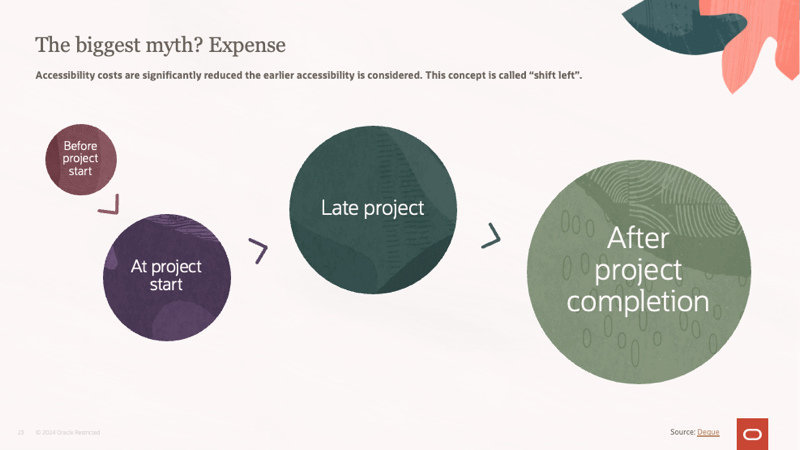The No. 1 impediment to creating more accessible and inclusive digital experiences is false preconceptions. When we have baseline misunderstandings and misconceptions about how our customers interact with our brands, we automatically limit ourselves from finding appropriate solutions.
In the 43-minute on-demand webinar below, I break down a number of accessibility myths, discuss accessibility solutions, and share advice from our Accessibility & Inclusive Design Ideas checklist (free, no-form download). However, in the remainder of this post, I spotlight the six biggest accessibility myths.
The 6 Biggest Accessibility Myths
These are repeated enough that you may believe they’re true, but they’re not.
1. Accessibility only affects a small group of users.
False. A whopping 27% of adults in the US live with a visual, hearing, motor, or cognitive disability, according to the CDC. There’s nothing small about that.
While their needs are diverse, most brands don’t do a good job of even addressing common challenges. For instance, color blindness is one of the largest populations of people, since it affects 8% of men, but color blindness checks are one of the most common accessibility failures.
2. Accessibility only helps people with disabilities.
False. The accommodations you make for people with permanent challenges also help people with temporary challenges and situational challenges, as we highlight throughout our Accessibility & Inclusive Design Ideas checklist. For example, using generous font sizes, legible fonts, and high-contrast text not only helps people with poor vision, but also people recovering from eye injuries and people reading your website or campaigns outside in bright sunlight.
This phenomenon is known as the Curb Cut Effect, because curb cuts for wheelchair users also help parents pushing scrollers, delivery people and others with carts, bikeriders, and so many others.
3. People with disabilities don’t engage with my brand.
True—if you make it impossible for them. It’s a self-fulfilling prophecy. However, if you make your experiences accessible, they will—along with lots of other consumers experiencing temporary and situational challenges.
4. My marketing campaigns don’t need to be compliant.
False. It’s not just physical spaces and websites that need to be compliant. The Americans with Disabilities Act (ADA) specifically calls out the requirement for accessible communications, too.
Better understand email accessibility.
5. Accessibility only needs to be resolved once.
False. While many accessibility best practices can be integrated into the coding of your website and email templates, for example, brands need to be mindful of accessibility every time they create a new experience. That’s because every bit of copy, every image, and every call-to-action contributes to inclusiveness, either positively or negatively.
Concerned about the accessibility of your marketing? Oracle Digital Experience Agency can perform an Accessibility Audit Workshop to compare your current marketing against our accessibility standards, review the results, and create a plan to move forward. Talk to your Oracle account manager or reach out to us at OracleAgency_us@Oracle.com.
6. Accessibility Is Time-Consuming & Expensive
False… or at least it can be false if you’re thoughtful about it. This myth, which is the one I hear the most, is very similar to the “People with disabilities don’t engage with my brand” myth in that it’s also self-fulfilling.
The core issue here is that if a brand creates a new experience and then tries to retrofit it so it’s accessible, then that’s when making accommodations is the most expensive. When you make it an afterthought, you make it expensive. And lots of brands make accessibility an afterthought.

However, if you think about accessibility from the very beginning of a project, it makes the whole process smoother, you eliminate surprises and big disconnects that require backtracking, and you make the cost of accommodations the cheapest.
Don’t fall victim to these six accessibility myths. Don’t expose your brand to potentially expensive and embarrassing ADA lawsuits by creating non-compliant experiences. But more importantly, don’t create subpar experiences that alienate people with permanent challenges and frustrate everyone else.
—————
Need help creating more accessibility and inclusive digital experiences? Oracle Digital Experience Agency has hundreds of marketing and communication experts ready to help Responsys, Eloqua, Unity, and other Oracle customers create stronger connections with their customers and employees—even if they’re not using an Oracle platform as the foundation of that experience. With a 94% satisfaction rate, our clients are thrilled with the award-winning work our creative, strategy, and other specialists do for them, giving us an outstanding NPS of 82.
For help overcoming your challenges or seizing your opportunities, talk to your Oracle account manager, visit us online, or email us at OracleAgency_US@Oracle.com.
To stay up to date on customer experience best practices and news, subscribe to Oracle Digital Experience Agency’s award-winning, twice-monthly newsletter. View archive and subscribe →
